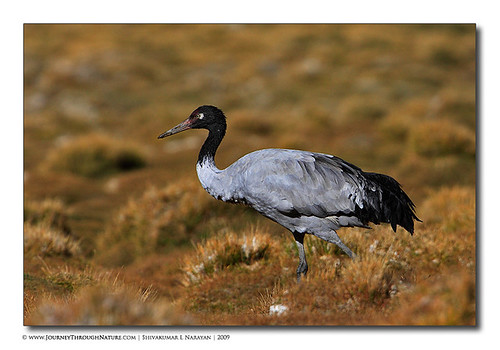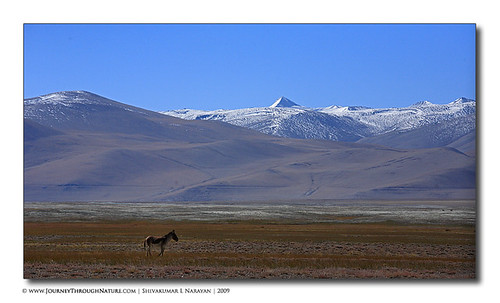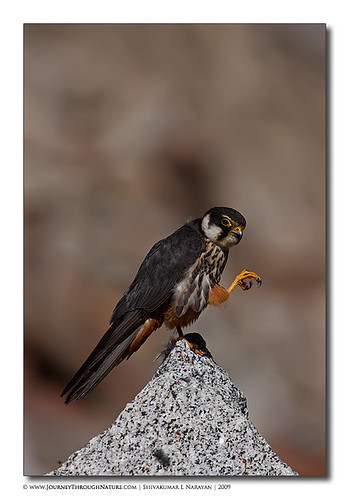 |
I hope am not doing this in a hurry – but in the first of the “few part” series of my Juley Ladakh series i will be presenting the Wildlife of Ladakh. Though for a common man it might sound strange as if Ladakh is meant for only Landscape or Travel images – as a wildlife enthusiast you will never fail to witness and feel the wide variety of birds and mammals it has to offer. One prime reason why any wildlife lover would like to visit is for the Black Neck Crane (Grus Nigricollis) which come all the way upto the wetlands of ladakh to breed during the summer season. Once season and the activity is over they fly over across to regions in Bhutan until the end of winter. Next thing that will come to anybody’s mind when we talk about mammals is the Snow Leopard. Its one of the most elusive cats found in our region. Apart from these some of the most common mammals of this region are Marmots which are common across all high pass region, Kiangs which are the only other Wild ass found in India other than the Asiatic Wild Ass found in Gujrat. Kiangs are much muscular and rugged and are confined to the high plateau regions of the Himalayas. The Bharal/Bluesheep/Mountain Goat are the very commonly found but difficult to sight mammals. The way these skittish beauties get camoflaged to the rocky hills of the himalayas is really a sight to see. At times it really takes a second or sometimes even a third look before you could actually track them to capture them on film, even if they are 50mts away from you. When it comes to Birds Horned Larks are found all over the place. Lammergier, Griffon, Eurasian Hobby are some of the highlight Raptors of the trip. Chukars are common where the hills are close to village settlements and when you keep a keen eye what one ( or rather ME ) mistakes as a Chukar might end up as Tibetan Snowcock. High altitude wetlands like TsoKar are the place to see Bar Headed Geese and Brahminy ducks along with numerous other wetland winged wonders. Brownheaded gulls are never a miss once you visit Pangong lake. Redstarts are equally common as the Horned larks but are only found at region where there is a stream or waterbody. Raven, Yellow billed cough, Red billed cough, Wagtails, Hill pigeons goes in against the checklist when you are on the move.
 |
Below i would like to list some of the memorable ( at times funny ) wildlife moments experienced or witnessed when on the field during the 10 day trip to Ladakh.
a. Day 3 we just crossed Tanglangla Pass (Second Highest Motorable Road @ ~17k feet) and hardly 50mts ahead i just saw a flock of birds cross the road. Assuming them to be Chukars I picked up the 300mm lens and started running behind them. I clicked about 4-5 frames and later i realised am panting for breath. Rushed back to the car and had water and later realized that it really takes some time to get acclimatised and doing stupid things will make matters worse 🙂 Once back in town when i went back to the images i realized what i actually saw was Tibetan Snowcock and not Chukar. Glad that i got some decent shots of them.
b. Day 5 – Heights of Weather – Standing outside the camp early in the morning at Tso Moriri, the temperature is so low and cold that even when the birds ( Redstart, Hill pigeons, Wagtails, Horned larks ) are at touching distance you are not able to touch the camera. The moment one takes the hands out of the pocket you start feel the temperature at your fingertips. But nevertheless enjoyed them watching at such close quarters.
c. Day 6 – In a desperate attempt to get a good shot of a BNC – waded right into the edge of the lake realizing that was in no man’s land stuck in 2ft deep slush ! Managed to get out of it bidding goodbye to an expensive shoe – but again to be stuck just 10mts away from the previous point. But no shoes to loose this time so managed to come out of it easily.
d. Day 7 – Morning at Tsokar is always magical either due to light or due to the place. Witnessed a pair of Raven chase ( probably to hunt ? ) a Turtle dove. As if the chase was planned to perfection – each of the two Ravens took turns when the other was tiered and they didnt leave the little dove even when it tried to hide under the rocks found near the camping site. The entire even was happening right in front of the eyes and the dove had a never say die spirit and gave them a nice run for close to 20mins.
e. Day 8 – Nubra valley – Anoop my friend who had accompanied for the trip gave me a shout and when i turned back at him all i could see on the ground was a bright orange colored object moving into the busy. Both of us were not sure as to what it was. After couple of mins a tiny squirrel sized mammal comes out with a tiny rat in its mouth – yes its a Weasel 🙂 Both of us were standing at the two exits of the bush and it had no other way apart from coming out of some strange place and leaping on top of small rocks and escape from us. With camera in hand we tried to run behind it to get some images and in panic mood the weasel left the rat halfway and ran behind a tree at the far end of the dune. Expecting it to come back in the same path we stood our ground and waited for some time. Instead of coming back directly and picking up the rat – the weasel opted to take a longer route to the bus where it had caught the rat, came out of the same very small opening where it had managed to escape from us, hopped on the small rocks and come and pick up the rat and run back towards the tree. Basically what it did by doing this is – it traced the same path what it had taken to hunt, escape from us and run towards the place where it had dropped the rat. All that i can say after witnessing this is the sheer memory of the tiny tot.
f. Day 10 – Drive towards Changla Pass – Backlit subjects always impress me more than anything and that too when its a raptor ( falcon ) sitting on a rock what best can i expect – just as we tried to approach the bird in an attempt to photograph as well as identify it, it flew off and went and sat high up in the road slightly at a distance from the road. Couple of hurried shots when in flight confirmed the bird to be a Eurasian Hobby – my second sighting after the far off sighting way back in 2007 in Ranthambore. As we drove up the hill we started giving up the hope of getting a good frame of the raptor. In an attempt to see how far the bird is – we eventually managed to shoo it away from its perch but later realized that it just went off to bring its morning breakfast – a fresh horned lark catch. It just came back to the same perch and got busy cleaning up the meal by plucking off all the feathers. Assuming that it wont go anywhere until it finishes the meal – we just started climbing down the steep hill and positioned ourself for a nice photosession with the raptor at close distance. Glad that the raptor was comfortable with our presence and contined to eat, clean, preen, and do everything and anything for 30 mins. Probably my closest encounter with a small raptor and first time of a raptor with a kill.
g. Day 10 – Last day of trip – Drive back from Pangong lake – We thought the trip is all over, 10 days of nice fun shooting and enjoying the beauty of mighty himalayas. We had almost called off shooting and had kept the cameras in the bag. I was almost about to doze off when Anoop shouted “Crane” in excitement looking outside the window – at first i thought he might be talking in his sleep but later when the vehicle stopped i realized what i was seeing was a pair of most elegant and majestic birds – The Black Neck Crane – feeding in a small marshy area close to the road. Wasting no time we rushed out of the car and started stalking them later realizing that they were not shy like the ones what we found in Tso Kar and also the region was far more safe for walking. All that we had to do was sit at about 20mts or so away from them and click to our heart’s content. The grace with which these birds walk and feed can only be matched or out-beaten by their local counterpart the Sarus cranes. Memories of shooting a pair of Sarus cranes at close distance just about a year back at Bharatpur was still looming in my head when ever i saw the BNCs through the lens. By far one of the best sightings and wildlife shooting satisfaction we had during the trip.
h. Day 10 – After shooting BNC and driving ahead we knew that the day is still not over and we might strike something lucky before we head down to Leh. We were not proved wrong when we saw Bluesheeps ( yes the ever shy bluesheep which runs 100mts for every inch you move ) standing right across the road on top of small boulders giving all sort of poses. The day still didnt end there after clicking the bluesheep – few more kms down the line we got to witness one of the most massive herd (clearly in excess of 100) of bluesheep comprising of massive males to tiny ones run across the slopes of the hills and cross the road and headed towards a small water body towards the left of the road. The scene i could say was just a miniature replica of a wildebeest migration what one gets to see at the savanna. The amount of joy one gets by seeing such scene – no images can match it.
Having said that i would end the small ( eh ? ) tit bits and notes from the field with regard to the wildlife sightings and experiences from Ladakh.
Please click here for the images from the trip – WILDLIFE of LADAKH
Coming up next would be the Landscapes of Ladakh. Stay tuned for that and hope to share some new perspectives from the Land of High Passes.
Until next time – Keep smiling.
 |


🙂 lovely shots…but quite a long writeup…so just done ..till ur 3rd day experience…will go through the rest..very soon…;)
Very interesting account of your trip and amazing wildlife pictures from Ladakh.. Looking forward to more 🙂
Nice pics… the post seems to be a good pointer for things to do in ladakh… i only briefly went thru it…but will ready it completely in the coming days…
Amazing pics to top up a fantastic trip report. Exquisite stuff. Awaiting my opportunity to visit this “Heaven on Earth”.
Fantastic images Shiva. You had a ball of a time in Ladakh. Keep them coming.
hi !
you got all beautys of ladak…beautifully…
really loved to see your photos…
great work
thanks
Excellent maga….this is an awesome perspective on things. Superb imagery to tag along as well….
Amazing photographs Shiva. Waiting for more.
Wonderful pics and thoroughly enjoyed the read !
Juley shiv,
Enjoyed the trip report, i was not so lucky as you, but could manage with few pics at Pangong Tso, Tso moriri & Tso kar
nice report…and good pics…
cheers
sathya
what an idia sir jeee….!